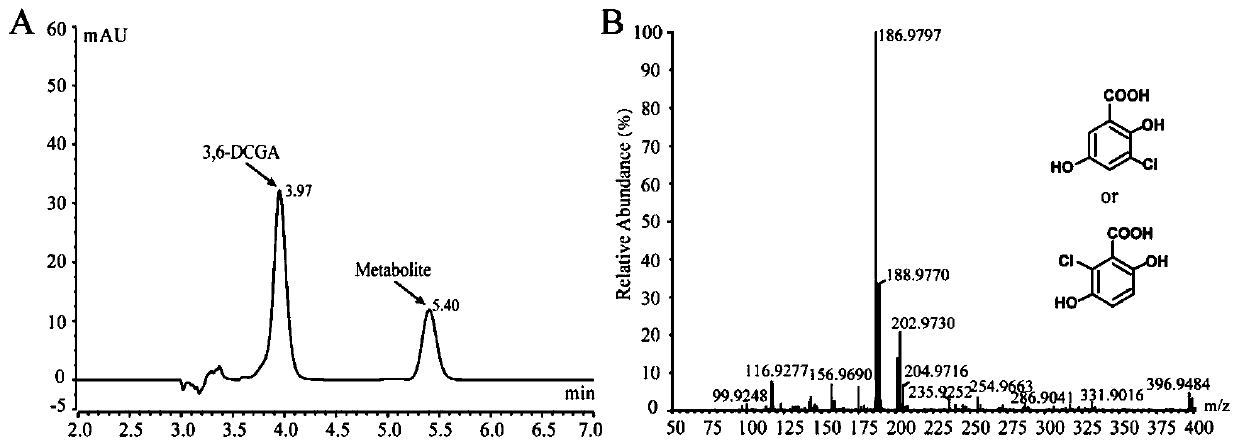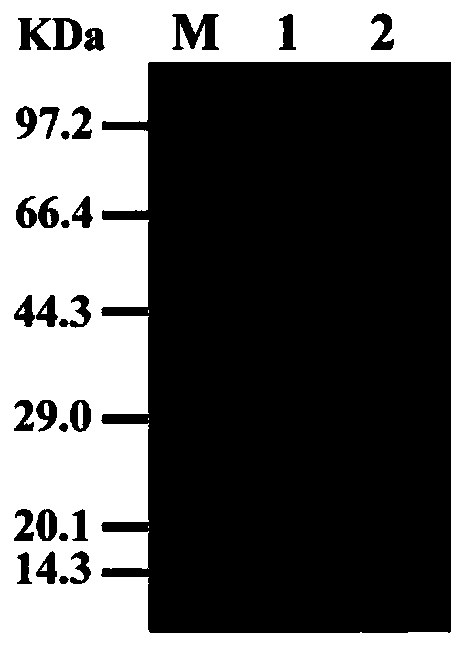Application of dicamba intermediate product 3,6-dichlorogentisate dechlorinase dsmh2 and its coding gene
A technology of dichlorogentisic acid dechlorination enzyme and dichlorogentisic acid, which is applied in the field of environmental microorganisms and agriculture, and can solve the problems that restrict the research of dicamba's environmental behavior and ecological safety.
- Summary
- Abstract
- Description
- Claims
- Application Information
AI Technical Summary
Problems solved by technology
Method used
Image
Examples
Embodiment 1
[0032] Cloning of embodiment 1.3,6-dichlorogentisate dechlorase gene dsmH1, dsmH2
[0033] 1.1 Metabolite detection
[0034] 1.1.1 Detection of crude enzyme 3,6-DCGA dechlorase activity of dicamba-degrading strain Ndbn-20
[0035] The strain used in this experiment is Rhizorhabdus dicambivorans Ndbn-20 (formerly named Sphingomonas sp.Ndbn-20), an efficient dicamba-degrading bacterium isolated by members of our laboratory. Ndbn-20 was cultured in 100ml 1 / 5LB liquid medium To the logarithmic phase, the cells were collected by centrifugation, washed twice with PBS buffer, resuspended in 10ml PBS buffer, ultrasonically disrupted (Auto Science, UH-650B ultrasonic processor, 30% intensity) for 5-10 minutes, and centrifuged at 12000rpm for 40min , collect the supernatant, which is the crude enzyme solution.
[0036]Enzyme activity reaction system (1ml): add PBS (50mM, pH 7.0), 0.1mM 3,6-dichlorogentisic acid, 100μl of crude enzyme solution, add different cofactors NADH, NADPH, GSH,...
Embodiment 2
[0039] High expression of embodiment 2 dechlorinase gene in BL21 (pET-24b (+))
[0040] 2.1 PCR amplification of dechlorinase gene
[0041] Forward primer: 5'-TAAGAAGGAGATATACATATGACCCATCTGGACCTGTACAATTAC-3' (SEQ ID NO.3), reverse primer: 5'-TGGTGGTGGTGCTCGAGGATCCCACCCTTCCAATTGGGCATC-3' (SEQ ID NO.4). dsmH2 was amplified from Ndbn-20 genomic DNA by PCR.
[0042] Amplification system:
[0043]
[0044] PCR amplification program:
[0045] a. Denaturation at 98°C for 3 minutes;
[0046] b. Denaturation at 98°C for 0.5min, annealing at 58°C for 0.5min, extension at 72°C for 1.0min, and 30 cycles;
[0047] c. Extend at 72°C for 10 minutes and cool to room temperature.
[0048] 2.2 Double digestion of PCR product and plasmid, product purification and enzyme connection
[0049] The PCR product was purified using a gel purification recovery kit. For specific methods, refer to the kit instructions. Purified PCR products and plasmids were digested with corresponding enzymes re...
Embodiment 3
[0071] Verification of the physiological function of embodiment 3 dechlorinase in bacterial strain Ndbn-20
[0072] In order to verify the physiological function of the dechlorinase in the strain Ndbn-20, the present invention constructed the dsmH2 insertion mutation vector, which is to insert the about 509bp dsmH2' fragment in the middle of the reductive dechlorinase gene into the PstI and BamHI restriction sites of pJQ200SK between points.
[0073] With forward primer: 5'-CTTGATATCGAATTCCTGCAGTTGATGAAGCTGGAGCATACGCGGC-3' (SEQ ID NO.5), reverse primer: 5'-GCTCTAGAACTAGTGGATCCGTCGTCCCATAGCCGGGCAAAATTC-3' (SEQ ID NO.6), dsmH2' was amplified.
[0074] The insertion mutant vector pJQ200SK was double-digested with PstI and BamHI, and the method for constructing the vector is shown in Example 2 for the construction of an expression vector. Transform the constructed vector into DH5α.
[0076] Insert donor bacteria DH5α(pJQdsmH2), acceptor bacteria ...
PUM
 Login to View More
Login to View More Abstract
Description
Claims
Application Information
 Login to View More
Login to View More - R&D
- Intellectual Property
- Life Sciences
- Materials
- Tech Scout
- Unparalleled Data Quality
- Higher Quality Content
- 60% Fewer Hallucinations
Browse by: Latest US Patents, China's latest patents, Technical Efficacy Thesaurus, Application Domain, Technology Topic, Popular Technical Reports.
© 2025 PatSnap. All rights reserved.Legal|Privacy policy|Modern Slavery Act Transparency Statement|Sitemap|About US| Contact US: help@patsnap.com



